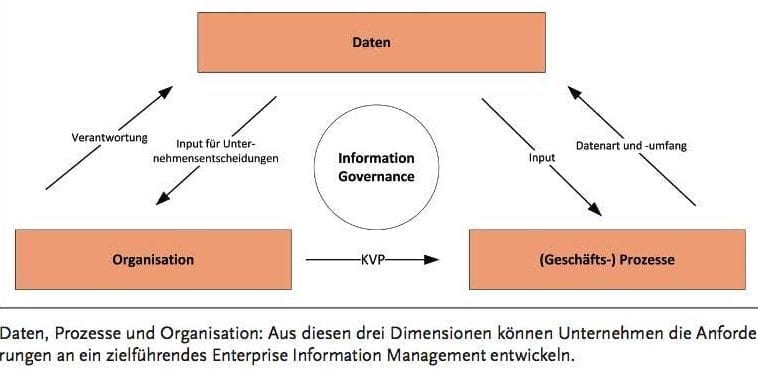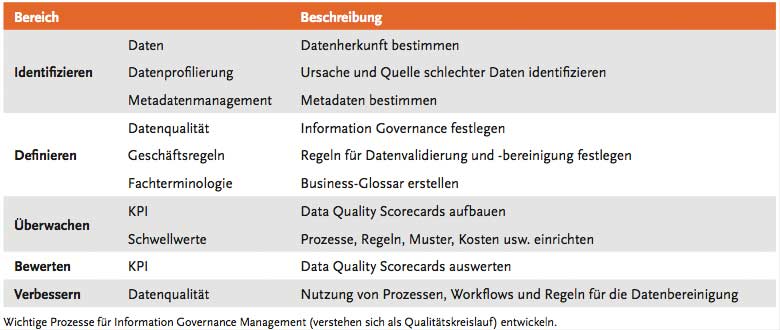A good tool is not enough
![[shutterstock:568907860, Saint A]](https://e3mag.com/wp-content/uploads/2017/02/shutterstock_568907860.jpg)

Driven by the digital transformation, data is gaining unprecedented importance in companies. The demand for quality and availability of data - in the sense of integration - is rising sharply.
This is countered by the fact that the necessary information management processes and tools have often not even been introduced or do not meet the requirements.
In addition to the uncertainty of correctly assessing the criticality of data, there is often a lack of knowledge on how to effectively derive information from data to increase competitiveness. Efficient business processes require high-quality data.
Managers should therefore establish appropriate ways of handling corporate data.
Practice shows that many questions can only be answered incompletely today, e.g.:
- What data is basically available in the company?
- Where are these data located, what is their quality?
- By whom and which systems is this data used?
- Who is responsible for the data?
- Which data represents added value for the company?
- Which data causes unnecessary costs?
Companies operate in a complex technologized environment where information is becoming increasingly valuable and business-critical; however, the data must be managed professionally.
A valid approach always considers the dimensions of "data", "processes" and "organization". The requirements for enterprise information management develop from these three dimensions. They must be aligned with the requirements of information governance.
This is more than ever a strategic task. With regard to data, questions arise about quality (specifications and processes), data efficiency/integration (data architecture and clear responsibility) and the management of the information lifecycle (specifications and processes).
In many companies, it has been recognized that data management is a "full time job" and cannot be done on the side. Like any new discipline, it must first be built up.
The automotive industry is currently experiencing that electric vehicles are not so easy to establish on the market. That's why, despite many years of experience in automotive engineering, they have gone over to setting up completely new divisions for electric vehicles in order to bring vehicles to series production readiness that will be accepted by customers.
Companies will experience a similar situation in information management; here, too, a certain learning curve cannot be avoided. It is therefore advisable to buy in professional support for the first steps, as this can save one or two painful experiences.
To begin with, responsibility for information management must be established; this is the task of the company's management. In many organizations, the role of Chief Data Officer (CDO) has been created for this purpose.
The CDO is a new C-level representative: He or she drives the digital transformation in the company, assumes responsibility in setting up processes and roles for information management, and ensures a clear understanding of the data architecture in the company.
He or she acts for the company-wide enforcement of the information governance defined and agreed upon by his or her area.

SAP Strategy
The importance of Enterprise Information Management at SAP is rising sharply.
The "new" technology Hana only really makes sense if high-quality data is available.
What good is an evaluation in seconds if the underlying data is inferior? Real-time is only useful if the data basis is defined and clean.
Today, S/4 Hana already offers extensive options for directly processing operational data from the Business Suite itself. This eliminates the need for data transfer and data processing in a separate data warehouse - a significant time gain.
Business departments are able to evaluate extensive data immediately and in real time without using a BW system. Data integration and data quality are also a key success factor in all Internet of Things (IoT) scenarios.
And for making predictions (predictive analytics) in real time, it is obvious that only a good database can deliver good results.
SAP has therefore launched an offensive for better integration and data quality with increasing centralization and consolidation, as can be seen in the tool landscape for Hana 2.0.
Solutions are collected and provided under the terms Hana Smart Data Access, Hana Smart Data Integration and Smart Data Quality.
Hana Smart Data Integration, SAP Smart Data Quality and Hana Cloud Integration (HCI) send a clear signal as to where SAP sees the customer's homework in the future. But established tools such as SAP Master Data Governance (MDG) are also being revised to better support customers in their tasks.
With MDG, SAP business workflows can be used that, for example, inform the data owner when master data is changed or duplicates are created.
In addition, compliance and auditing requirements can be met with tracking of all changes and approval processes.

Recommendations
Despite the numerous tools in the enterprise information management environment, no company gets where it wants to go just by implementing tools.
As consultants, we therefore start with our clients in setting up the necessary organization and support this with a meaningful analysis of the data stock.
In this context, it is less important to know how many gigabytes of data are located where than which data are generated where in the company, who "owns" them, what value they have for the company and which legal requirements they are subject to.
As mentioned above, roles and responsibilities in information management need to be adapted to meet these tasks.
In addition to the CDO, this is the data owner who is responsible for a data domain in the company - often from the area that has the greatest knowledge of the relevant data (e.g., customer data in sales).
A data architect is responsible for a holistic data architecture; he integrates data and relates them to each other.
A data steward supports the data owner in the quality assurance of data and ensures during operations that the data meets the requirements for correctness, consistency, relevance and completeness.
Existing roles such as business process managers must be integrated into enterprise information management.
The approach must always be viewed holistically; it requires a rethink in the perception and handling of data among senior and middle management.
Only downstream, the use of tools ensures the quality-assured generation and provision of data in the business processes throughout the company.
The Alegri White Paper "SAP Data Management. New Challenges with Hana" sheds light on further aspects and can be requested free of charge.
Cornerstones for the strategic alignment for Hana Data Integration
Adaptive Tooling:
Provision of a toolbox that can be used for different technologies through a flexible licensing model without having to license specific components each time.
Hana-Centric:
Administration and monitoring as well as security are completely mapped via Hana tools.
Support Disparate Data for Digital Business:
A wide variety of data pools can be made accessible "out of the box" and processed in the central Hana system.
Automated Data Provisioning:
A self-learning system that detects and processes data in order to provide it in a performance-optimized way.
Data and Application Integration:
Support messaging and other interfaces to leverage data and app paradigms.
Hybrid Deployment Model:
The tools available are always the same, whether as a cloud service or an on-premise installation.






